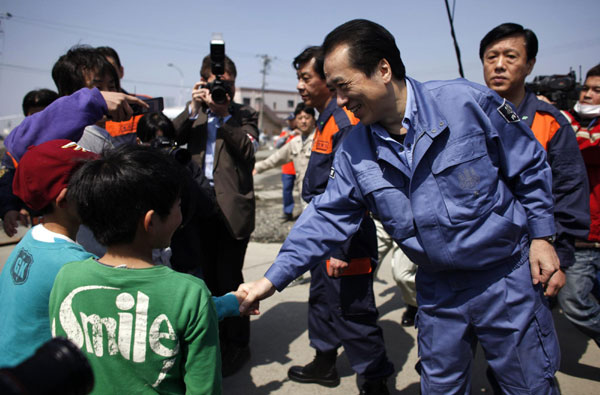Asia
Japan's PM visits fishing city wrecked by tsunami
Updated: 2011-04-10 18:55
(Agencies)
TOKYO - Japan's Prime Minister Naoto Kan paid another visit to Japan's tsunami-devastated coast Sunday, promising officials in a fishing-dependent city that his government will do whatever it can to help.
Kan visited Ishinomaki, a coastal city of 163,000 people in Miyagi, one of the prefectures (states) hardest hit by the March 11 earthquake and tsunami that killed as many as 25,000 people, destroyed miles of coastline and left tens of thousands homeless.
"The government will do its utmost to help you," Kan, dressed in blue work clothes, told local people gathered near the sea. "We will support you so that you can resume fishing."
While Kan was visiting Ishinomaki, Japanese and US troops fanned out along the coast in another all-out search for bodies by land, air and sea.
Television news showed them using heavy equipment to lift a boat washed inland by the tsunami so they could search a crushed car underneath. No one was inside.
"A month after the earthquake and tsunami, many people are still missing," said Japanese defense ministry spokesman Norikazu Muratani. "We would like to do our utmost to find bodies for their families."
Only 13,000 deaths have been confirmed so far, and many bodies have likely washed out to sea and will never be found.
A similar three-day search with even more troops a week ago found just 70 bodies, underscoring the difficulties of locating victims in the ocean and the debris along the coast.
In coastal Fukushima on Sunday, a middle-aged man watched as soldiers in scuba gear dove underwater. He hoped they would locate his younger brother, a fisherman who was swept away.
"He must be trapped in the boat," the man told public broadcaster NHK, which did not identify him. "I'm just praying soldiers will find him."
The latest search was to last just one day and did not include the 12-mile (20-kilometer) evacuation zone around the tsunami-flooded Fukushima Dai-ichi nuclear complex. Police officers decked out in full protective gear continue the dangerous, painstaking task of looking for bodies inside that zone.
Workers at the complex have spent the past month frantically trying to stop radiation spewing from nuclear reactors by restoring the cooling systems, but they still have a long way to go.
Contamination in water pooling around the complex has slowed efforts to stabilize the reactors, emitting so much radiation in some places that workers can get in only for short periods of time, if at all.
In a move that prompted some criticism from neighboring countries, engineers decided earlier this month to deliberately pump less-contaminated water into the ocean from a storage facility they thought might make a good receptacle for the more highly radioactive water. They are also pumping out water from drains to keep it from backing up.
"I would like to apologize from my heart over the worries and troubles we are causing for society due to the release of radiological materials into the atmosphere and seawater," Sakae Muto, a vice president of the nuclear plant's operator, Tokyo Electric Power Co., said Saturday.
The pumping was set to end Sunday, and officials hoped that within days they could start transferring the more highly contaminated water to the now-drained facility. The operation is risky because the water will be transferred through a hose snaking around buildings on the complex, meaning that if there are cracks or leaks in the hose, radiation could escape into the air.
E-paper

Green light
F1 sponsors expect lucrative returns from Shanghai pit stop
Buying into the romance
Born to fly
Light of hope
Specials

Share your China stories!
Foreign readers are invited to share your China stories.

No more Mr. Bad Guy
Italian actor plans to smash ‘foreign devil’ myth and become the first white kungfu star made in China.

Art auctions
China accounted for 33% of global fine art sales.





